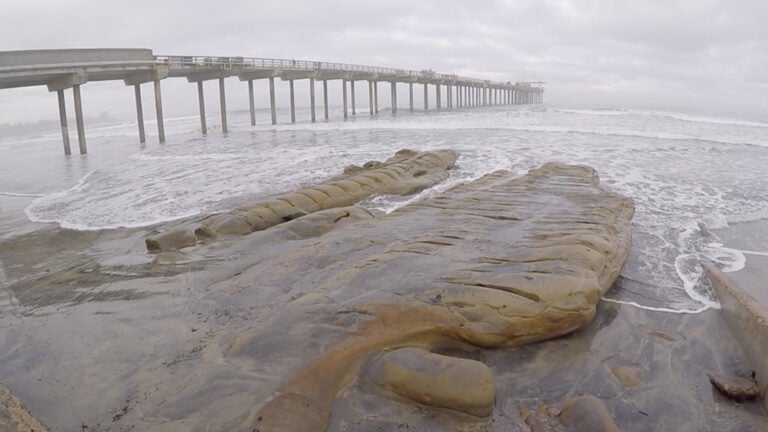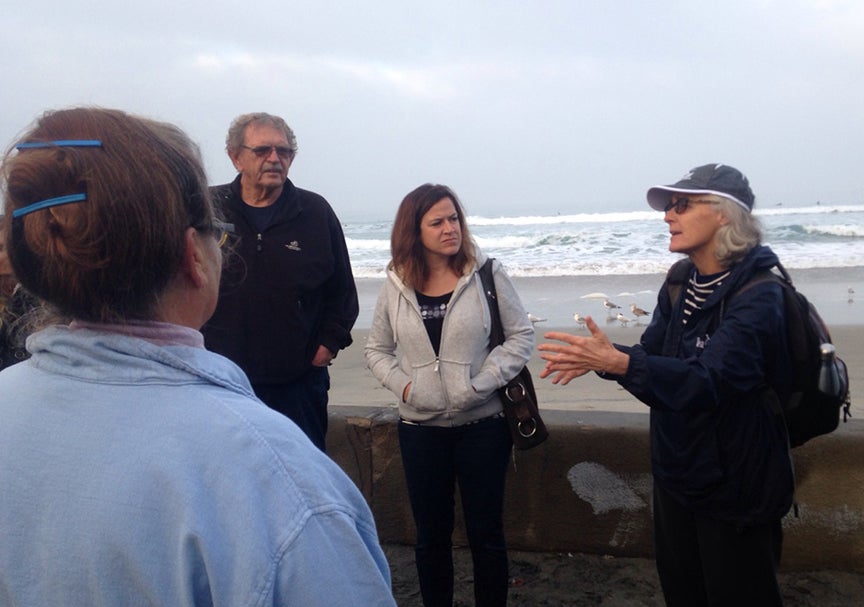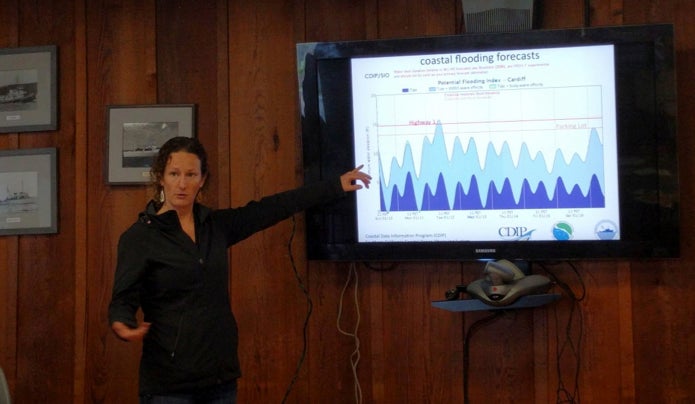
Pier and exposed rocks at Scripps Institution of Oceanography. These rocks are burried under sand for most of the year.
Rising Sea Levels: Empowering Communities through Citizen Science
Gray skies, high tides, and smiling strangers: that’s what greeted me as I arrived at La Jolla Shores for the Urban Tides Beach Walk. As we walked along the beach, waves lapping at our feet, images of the shoreline several weeks back flashed across my mind. Instead of a uniform landscape of sand, boulders rose up and the original “Scripps Institute of Oceanography” sign proudly stood, cleared of sand. We murmured, How did this happen?
That’s what we had gathered together to talk about. This season, climate change and El Niño are taking the world by storm—at least in Southern California. These factors exacerbate sea level rise, heavily battering the shores through runoff and wave action. The result? Flooding, erosion, and exposure of previously buried landmarks.

To help keep tabs on these natural hazards, researchers from Scripps Institute of Oceanography (SIO), Southern California Coastal Ocean Observing System (SCCOOS), US Geological Survey, and California Sea Grant create models to identify regions most at-risk of flooding and erosion. By teaming up with USC Sea Grant, the Urban Tides Community Science Initiative, a citizen science program, was born. How it works is simple: anytime you are at the beach, you can snap a picture and upload it into the database using a smart phone app or your computer (see guidelines). Researchers can then use these photos to ground-truth their models. This in turn helps city planners and communities better prepare for the impacts of future sea level rise and storm events.
To further engage the community, beach walks are held to teach citizen scientists the in-depth science behind pictures, train them in app use, and bring together scientists and stakeholders.
That’s what the stroll along the beach was all about. On January 20th, a beach walk at La Jolla Shores, CA, gave people first hand experience to the “king tides”: the highest of the high and the lowest of the low. Waking up at 6 AM, meeting at 7…not ideal. But it was incredibly rewarding. Not only did I meet community members, but learning directly from experts floored me. Did you know that the city hires bulldozers to move sand as an adaptation method? How about how the parking lot was completely flooded by recent rains and waves? And tides—these systems are so well studied, that 10 years ago, experts could tell you this year’s king tide days. Wow.
The walk traveled from La Jolla Shores to Scripps Institution of Oceanography, and there a short lecture was held. Dr. Sarah Giddings (SIO) discussed the science while Linda Chilton (USC Sea Grant) gave us training to lead walks. Not only did we receive technical education, but Urban Tides provided the resources and tools to share this experience with others. In short, it lived up to its namesake—it created a sense of community.
I also developed a unique relationship with Urban Tides: I am working under Dr. Giddings to analyze the efficacy of the program and how we can enrich the experience for the parties involved. More importantly, I believe that citizen science programs are two-way streets: the research benefits from the community and the community gains from the science. Urban Tides aims to do exactly that, but to what extent are we succeeding?

Evaluating the efficacy of the program, and making adjustments as needed, enables Urban Tides to be a good investment of our time and effort. More importantly, it will have a bigger impact within our coastal communities. To establish a functional program, we need to understand our community:
Who cares about the local region? Why? How can we help them?
After all, this is a citizen science program, which is only operational if the is community involved. Stay tuned for our results!